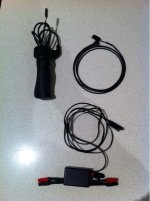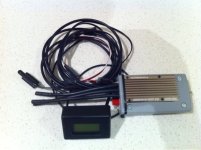adrian_sm
1 MW
BrainBox Update:
The button throtle, 8x2 LCD BrainBox with datalogging and temp sensor is all up and running, and working like a champ. But it has highlighted a few minor things I would like to resolve.
1) Wheel Sensor
- The current design places the wheels sensor at the rear wheel
- Fine for road bikes with narrow frames, but not good for MTBs with wide frames as the sensor needs to be spaced out to see the magnet
- So do I add wire length to route it to the front, or rely on people spacing out the sensor if needed?
2) LCD Contrast
- I used to be able to ground the contrast to get the right LCD constrast, but my new supplier's LCDs require ~1.0v to get the contrast right
- This means (a) I need to add a pot and adjust it for each screen, (b) it upsets the contrast depending on whether the BB is powered via the ESC or USB. : (
3) LCD Display
- Currently I have the display showing; current speed, Distance travelled, and battery fuel gauge as a horizontal bar graph. (top image below) All other stats can be scrolled through while at rest, with the battery gauge always displayed (see rest of images)
- This is great for fuss free riding, but occasionally I find I would like to see other stats while riding. The issue is screen realestate.

- I am thinking of changing the top line to be speed & battery percentage, then use the bottom line for a user selectable stats from: power, amps, volts, wh/km, average power, dist remaining, distance travelled, trip time, wh used, temperature, Total Kms, Total Time, Total kWh, etc.
- Then which ever stat is selected remains on the bottom line during the ride.
- To change the stat you would need to perform a momentary button press from zero power, either at rest, or during the ride by powering off, doing a quick button press, then getting back on the power

4) Wiring Layout
- Currently everything is hardwired that can be, requiring the following to be connected:
---- power inline sensor between battery and ESC
---- ESC throttle
---- Temp sensor
- The battery and ESC currently form a sort of package on its own when installed
- This means if you want to remove the battery, you need to disconnect quite a few things. I charge the battery on the bike so it isn't an issue for me, but it may annoy others.
- I need to look at all the possible layouts, and locations of various components to see which is the best compromise again. I think something that allows you to quickly remove the battery, leaving everything else attached to the bike would probably be desireable. But that would probably require seperately mounting the ESC, and possibly mounting the uC, SD, and USB connection in the main LCD enclosure. Which is very difficult for the 8x2 enclosure I selected, but possible for the 16x2. It just makes weather proofing more difficult while keeping access to the SD card and possibly the USB connection.
- I need to resolve weather proofing in general so perhaps I should just solve both these issues at once, by mounting the ESC, uC, SD, USB all in an aluminium enclosure like the hammond boxes, or in a plastic enclsoure like my v1 BrainBox.
So everything is functional and robust, but it still needs a little bit of tweaking before release.
- Adrian
P.S. I am seriously considering removing the SD datalogging, as it takes up 1/3rd of the programming space, I am hitting SRAM limits, it is stopping me from implementing a few things I would like to, and most average users won't ever use it. But I know the ES crowd will love it, as it essentially automatically records real time & summary data for every trip you take.
The button throtle, 8x2 LCD BrainBox with datalogging and temp sensor is all up and running, and working like a champ. But it has highlighted a few minor things I would like to resolve.
1) Wheel Sensor
- The current design places the wheels sensor at the rear wheel
- Fine for road bikes with narrow frames, but not good for MTBs with wide frames as the sensor needs to be spaced out to see the magnet
- So do I add wire length to route it to the front, or rely on people spacing out the sensor if needed?
2) LCD Contrast
- I used to be able to ground the contrast to get the right LCD constrast, but my new supplier's LCDs require ~1.0v to get the contrast right
- This means (a) I need to add a pot and adjust it for each screen, (b) it upsets the contrast depending on whether the BB is powered via the ESC or USB. : (
3) LCD Display
- Currently I have the display showing; current speed, Distance travelled, and battery fuel gauge as a horizontal bar graph. (top image below) All other stats can be scrolled through while at rest, with the battery gauge always displayed (see rest of images)
- This is great for fuss free riding, but occasionally I find I would like to see other stats while riding. The issue is screen realestate.

- I am thinking of changing the top line to be speed & battery percentage, then use the bottom line for a user selectable stats from: power, amps, volts, wh/km, average power, dist remaining, distance travelled, trip time, wh used, temperature, Total Kms, Total Time, Total kWh, etc.
- Then which ever stat is selected remains on the bottom line during the ride.
- To change the stat you would need to perform a momentary button press from zero power, either at rest, or during the ride by powering off, doing a quick button press, then getting back on the power

4) Wiring Layout
- Currently everything is hardwired that can be, requiring the following to be connected:
---- power inline sensor between battery and ESC
---- ESC throttle
---- Temp sensor
- The battery and ESC currently form a sort of package on its own when installed
- This means if you want to remove the battery, you need to disconnect quite a few things. I charge the battery on the bike so it isn't an issue for me, but it may annoy others.
- I need to look at all the possible layouts, and locations of various components to see which is the best compromise again. I think something that allows you to quickly remove the battery, leaving everything else attached to the bike would probably be desireable. But that would probably require seperately mounting the ESC, and possibly mounting the uC, SD, and USB connection in the main LCD enclosure. Which is very difficult for the 8x2 enclosure I selected, but possible for the 16x2. It just makes weather proofing more difficult while keeping access to the SD card and possibly the USB connection.
- I need to resolve weather proofing in general so perhaps I should just solve both these issues at once, by mounting the ESC, uC, SD, USB all in an aluminium enclosure like the hammond boxes, or in a plastic enclsoure like my v1 BrainBox.
So everything is functional and robust, but it still needs a little bit of tweaking before release.
- Adrian
P.S. I am seriously considering removing the SD datalogging, as it takes up 1/3rd of the programming space, I am hitting SRAM limits, it is stopping me from implementing a few things I would like to, and most average users won't ever use it. But I know the ES crowd will love it, as it essentially automatically records real time & summary data for every trip you take.












